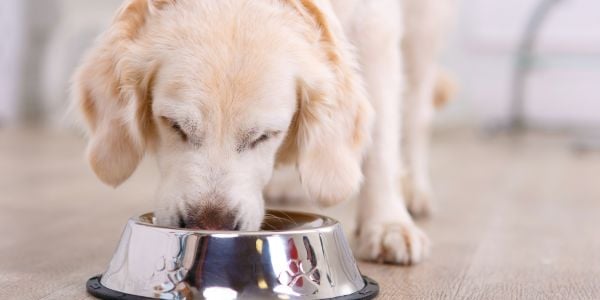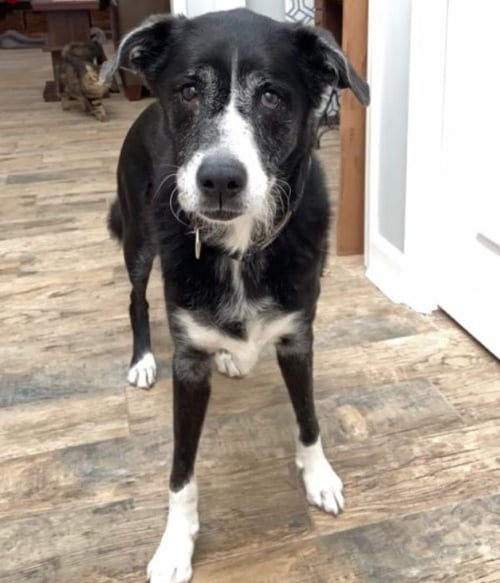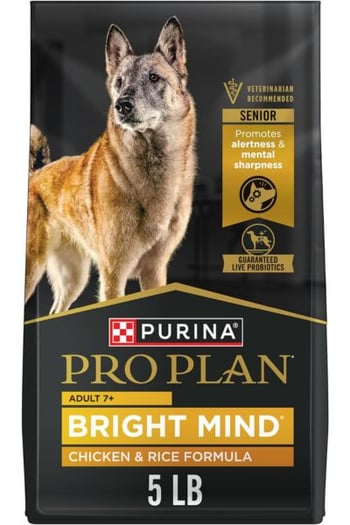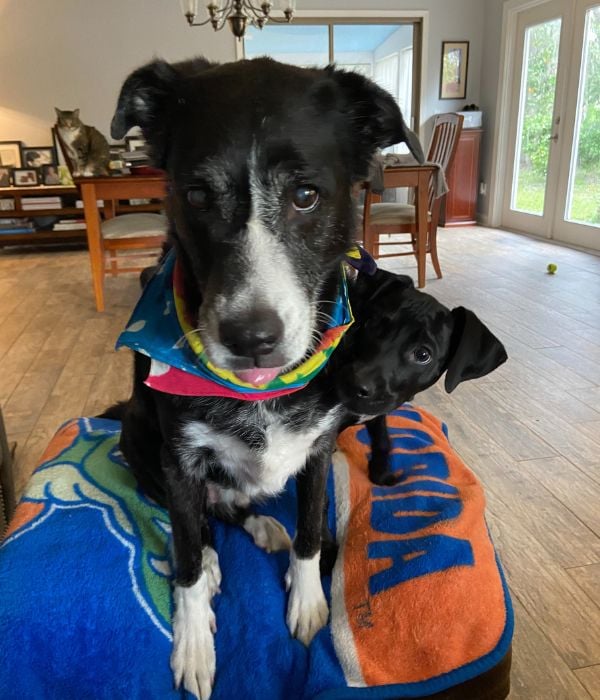 Most of you will say, without hesitation, that you consider your dog an integral part of your family.
Most of you will say, without hesitation, that you consider your dog an integral part of your family.
From puppyhood to old age, the ability to care for our canine companions continues to evolve and improve as new treatment protocols, medications, and dietary choices become available.
Making educated choices with respect to senior diets is a way for pet parents to play a pivotal role in contributing to the longevity and overall quality of life of their dog throughout his or her senior years.
Skip to section:
Consider These Things Before Choosing a Diet for Your Senior Dog
When considering the nutritional needs of senior dogs, we must take into account several factors:
Diet Composition
Senior dogs require a diet with an appropriate balance of protein, fat, and fiber to help maintain their lean muscle mass while avoiding increased weight gain1.
A common misconception about senior dogs is that they require less protein and fat in their diets than dogs that are younger and more active. The reality for senior dogs, however, is that their longevity depends on their ability to maintain lean muscle mass. While some loss of muscle mass is to be expected in older dogs, much like we see with older people, it can also be an indication of underlying changes in a dog’s overall health.
Studies suggest that senior dogs actually require about a 50% increase in high-quality protein in their diets to help them maintain their lean muscle mass.2
Prevention of Obesity
As dogs age, their daily activity often begins to slow down – they tend to play less and rest more than younger dogs. With a downturn in their activity level and a gradual decline in their metabolism, senior dogs may begin to experience a shift in their lean muscle-to-fat ratio.
As lean muscle is lost and the relative percentage of body fat increases, senior dogs become much more susceptible to developing other health conditions. The diseases we most commonly see with overweight senior dogs include arthritis, respiratory disease, heart disease, and diabetes, all of which can contribute to a poorer quality of life and, in some cases, a shortened lifespan.
Portion Control
Establishing set meal times and measuring the amount you feed are not only great ways to control their caloric intake, but it can also be a great tool for you to quickly recognize any unusual changes to your dog’s daily routine.
For example, dogs that graze from a large unmeasured bowl of food throughout the day may not raise red flags about an overall decline in intake as quickly as those who are meal-fed.
Palatability
Providing a tasty diet that senior dogs will eat regularly is very important to ensure that their nutritional needs continue to be met.
As dogs age, their sense of smell starts to diminish, causing them to be less interested in their dry kibble. Canned diets can be more appealing due to their stronger aromas, so mixing canned food or a tasty gravy-based topper into their kibble may help spark their appetites. Adding warm water to kibble or canned food can release more aroma as well.
It also helps keep your dog hydrated (see the next section below).
Diets that are restricted in sodium and fat are also often less palatable, which creates a serious dilemma for pet owners whose dogs are on prescription diets for specific conditions like kidney disease or heart disease.
If your dog is not crazy about their prescription diet, you might try adding a sweet treat to their kibble like real maple syrup or honey to encourage them to eat. For these types of additives, as little as 1 teaspoon can be more than enough to encourage your dog back to their bowl.
Fresh fruits like blueberries, bananas, apples, or watermelon can also be diced up and mixed into the kibble as a sweet, healthy snack. See our full list of pet-safe fruits and how much to give a day.
Water
Water is THE most important single nutrient that every dog needs, regardless of age. For pet owners whose senior dogs don’t regularly drink enough water on their own, ensuring adequate water intake sometimes requires a little creativity.
Offering a combination of dry kibble and canned food or adding water to dry kibble before a meal are both excellent ways to ensure a passive intake of fluids each day. Some dogs may actually prefer to drink from a fountain than from a bowl of still water, so don't hesitate to offer a variety of options to promote water intake.
If you are concerned that your dog isn’t drinking enough water each day, consider adding a hydration support supplement like Nulo’s Hydrate for Dogs Water Flavoring, which adds an appealing flavor in addition to electrolytes and B-vitamins for energy and amino acids to support the maintenance of muscle health.
Another DIY option would be to add a small amount of water drained from canned tuna, like Starkist Selects – No Salt Added Chunk White Albacore Tuna in Water.
These options can add flavor to a boring meal and promote necessary water intake without the addition of extra sodium or other ingredients that aren’t healthy options for your dog.

How to Choose a Diet for Your Senior Dog
Trying to select the right diet for your senior dog can be absolutely overwhelming. While dogs are usually designated as ‘seniors’ once they reach 7–8 years of age by most dog food manufacturers, this age milestone can be very misleading.
For example, a healthy 7-year-old Chihuahua may still have 8–10 years of life expectancy left, whereas a 7-year-old Great Dane may only reach 9 or 10 years of age.
If you are considering a diet change for your dog, we recommend consulting your regular vet for their guidance on the best diet options to meet your pup’s specific needs. Your vet can make thoughtful recommendations for your dog based on their health history, as well as guide you on the safest way to transition from the old diet to a new one.
If you’re interested in doing some diet research on your own, we recommend focusing on diets that meet the recommended nutritional guidelines from AAFCO (Association of American Feed Control Officials). The AAFCO guidelines define what is required for a diet to be considered nutritionally complete and balanced for a specific life stage.
You can also read more about life stage recommendations for essential nutrients through the National Resource Council’s publication of “Your Dog’s Nutritional Needs.”
See below for what I chose for my senior dog.
Key Dietary Components for Senior Dogs
Protein & Fat
Protein is one of the most important components of a dog’s diet. A common misconception for feeding senior dogs is that their diet should be low in fat and protein in order to prevent weight gain.
The reality for senior dogs, however, is that they actually need a higher percentage of good quality, human-grade protein in their diet to help maintain their lean muscle mass.
However, limiting fat in a senior dog’s diet is essential for several reasons. A diet that is disproportionately high in fat and lower in protein will work against the body’s ability to maintain lean muscle mass. An excess of fat in the diet can also lead to obesity and predispose dogs to other conditions like pancreatitis.
Obese dogs are also more likely to develop arthritis, heart disease, respiratory issues, and metabolic conditions like diabetes mellitus.
Healthy senior dogs should have diets that contain at least 25% protein, but this percentage may need to be decreased in diets for dogs who have been diagnosed with kidney disease. Fat content in senior dog diets can vary widely depending on the preparation (dry kibble vs canned diet), so it’s best to discuss dietary recommendations with your vet to determine an acceptable percentage of fat in your dog’s diet.
As a general rule, senior designated diets should have a roughly 2:1 protein:fat ratio in their nutritional composition.
Fiber
Fiber plays a critical role in the diet of senior dogs by helping them feel full more quickly, which, when coupled with a high-quality protein source allows for an overall reduction in caloric intake without the loss of satiety. Fiber can also play a key role in bulking up the stool to aid in normal bowel movements due to its low digestibility.
Fiber should comprise 2%–5% of a dog’s diet, but some diets may contain upwards of 10% fiber. If a diet transition is not an option for your dog but added fiber would be beneficial, consider offering some healthy options like cooked sweet potato, plain canned pumpkin puree, sliced celery, or uncooked green beans.
These vegetables contain fiber that can be helpful in regulating your pup’s stools while making them feel like they are getting a special treat.
Sodium
Sodium is a necessary ingredient in dog diets for palatability (otherwise, dogs likely won't find it tasty enough), but for senior dogs, the appropriate amount of sodium in their diet may need to be adjusted due to underlying health conditions.
Dogs who are suffering from kidney disease or hypertension are often transitioned to a diet that is lower in sodium to avoid fluid overloading the kidneys and vascular system. If your dog is not enjoying their food, there are some tips in our article you may try, but always ask your veterinarian first, as the "toppers" you may choose may not be appropriate for your dog and their health condition.
If your dog isn't eating, ask your veterinarian about a prescription appetite stimulant, which may help. Ensuring your dog eats enough is critical.
Phosphorus
Most commercially balanced diets contain phosphorus as part of their nutrient profile, which rarely causes a problem for an aging but otherwise healthy dog. However, studies have shown that dogs with kidney disease cannot excrete phosphorus normally as their kidney function declines, so offsetting phosphorus excesses in the body can be achieved by feeding a diet that is lower in phosphorus.
As a general rule, most commercially balanced dog diets will contain phosphorus levels between 0.6% and 1.3% depending on the life stage and breed designation. If your dog has been diagnosed with kidney disease, however, you should consult with your regular veterinarian for diet recommendations that contain between 0.2 and 0.5% phosphorus (dry matter).
Phosphorus levels in a diet are related to its protein content, so diets that are restricted in protein will typically also have lower dietary phosphorus levels. While this can be a benefit for dogs with kidney disease, you do have to strike a balance on protein levels in the diet that will also sustain your dog’s protein requirements for maintaining muscle mass, as we discussed earlier.
Omega-3 Fatty Acids
While excess fat in the diet can lead to obesity in dogs, diets or supplements containing fatty acids can actually provide many health benefits. Fatty acids such as EPA (eicosapentaenoic acid) and DHA (docosahexaenoic acid) provide protection against degenerative joint changes in dogs who are experiencing mobility issues.3
These fatty acids reduce the body’s inflammatory responses linked with allergic skin disease, gastrointestinal issues such as IBD (inflammatory bowel disease), and oxidative cellular damage to the brain that can lead to cognitive dysfunction. EPA and DHA have also been shown to support heart health by reducing cholesterol levels in the bloodstream.
A great way to add omega-3 fatty acids to your dog's diet is to add fish oil. We have several recommendations on how to supplement with fish oil.

Special Dietary Enhancements for Senior Dogs
Appetite Stimulants
For a dog who is struggling at mealtime because they don’t like the taste of the food, or they’re dealing with a medical condition that has caused their appetite to decrease, you may want to consider discussing appetite stimulants with your veterinarian.
Both these medications need to be prescribed by a veterinarian:
- Entyce (capromorelin) is an FDA approved veterinary appetite stimulant which works by mimicking ghrelin, a hunger hormone that is naturally produced in the body.
- Mirtazapine is FDA-approved for human use but has been shown to reduce nausea and enhance appetite in dogs with underlying health concerns such as kidney disease and those undergoing chemotherapy.
Treats
Treats are a great way to reinforce the human-animal bond, but they shouldn’t make up more than 10% of a dog’s total daily caloric intake. Human food ‘treats’ like green beans, cooked sweet potato, carrots, apple slices, blueberries, and broccoli are just a few of the low-calorie options that can be offered in place of more traditional dog biscuits.4
See our list of pet-safe fruits and vegetables that you can treat your dog with. We also list how much they can safely eat a day.

Supplements
There are hundreds of supplements on the market that target every aspect of a dog’s life, from puppyhood to senior status. Many of those are specifically tailored to aid or avoid a particular health condition, but the choices available for pet owners can be overwhelming.
A good rule of thumb is to search for supplements that are ‘NASC approved,’ meaning they have been vetted through the National Animal Supplement Council5.
NASC-approved supplements have been vetted through quality assurance testing to confirm that their ingredients are responsibly sourced and that the product being purchased by consumers is safe and healthy for their pets.
Supplements for joint pain
For dogs who are experiencing decreased mobility due to joint pain, joint supplements can be a great option to add to their daily mealtime routine.
Supplements such as Fera Pets Hip & Joint, Finn Hip & Joint, Glycoflex, Cosequin, Dasuquin, Dr. Buzby's, and Zesty Paws offer a variety of combinations of glucosamine, chondroitin, MSM, hyaluronic acid, turmeric, and green-lipped mussel (GLM) to provide antioxidant benefits and slow the progression of degenerative changes to the joints.
These components reduce inflammation in the joints and can help slow the progression of degenerative changes by stimulating cartilage repair.
My dogs have been on Cosequin for years and have done really well on it.
Supplements for brain and cognitive dysfunction
For dogs that are showing signs of cognitive dysfunction, or ‘doggie dementia,’ omega fatty acid supplements containing EPA and DHA provide antioxidant support which slows degenerative cellular damage in the brain. These are a great option to include in your dog’s daily mealtime routine as either a chew treat or liquid if they’re not already on a brain-support diet.
NASC-approved omega fatty acid supplements include Vetriscience Omega 3,6,9 gelcaps, Zesty Paws Cognition Bites, and Dechra's Eicosaderm liquid.

Diets for Specific Conditions
As senior dog health conditions have become more widely understood, veterinary nutritionists have worked to formulate diets tailored to provide specific nutritional support for these needs.
There are a number of prescription diets available through Hill’s, Purina, and Royal Canin that are specifically formulated for dogs with kidney disease, urinary issues, liver disease, cognitive dysfunction, diabetes, heart disease, dental disease, and cancer.
If your dog has been diagnosed with any of these conditions, ask your veterinarian if a prescription diet might be appropriate for their needs.
Cognitive and joint health diet
For those dogs that may not be ready to transition to a prescription diet, pet owners can consider over-the-counter (OTC) diet options as early intervention alternatives.
One of the best diets currently available for both canine cognitive dysfunction and joint health is Purina Bright Mind. This diet is formulated with EPA, glucosamine, and probiotics to provide nutritional support from nose to tail!
My oldest dog, Sam (featured above and below), began to experience cognitive decline and mobility issues around 12 years of age.
He started having accidents in the house, which hadn’t happened since he was a puppy in the throes of housetraining, and was having trouble remembering where his food and water bowls were located.
We transitioned Sam to Bright Mind kibble and wet food (he was losing interest in eating only his dry kibble, so the addition of the wet food was definitely a treat for him), and within a couple of weeks, we began to notice a gradual return to normal with his daily routine.
Sam was eating well and maintaining his weight; he was more engaged and playing regularly with our younger dogs, and the frequency of his household accidents dropped significantly.
In addition to the Bright Mind diet, we also supplemented Sam with Zesty Paws Cognition Bites for additional cognitive support.
Sam crossed the rainbow bridge in January of 2024, just shy of his 14th birthday, due to the progression of his mobility issues that could no longer be managed with NSAIDs and joint supplements to keep him comfortable.
It was devastating to lose our family companion of so many years, but I truly believe that without the diet change, we would have lost him much sooner.
In spite of his physical discomfort, Sam still seemed much happier and more ‘present’ in our daily lives than he had prior to the diet transition.

Sam was a great dog, featured above with baby Franklin. He put up with me dragging more little fosters, bottle babies, and sick things home than any dog should ever have to. ❤️
Nutrition is the foundation for good health and quality of life. If you have any questions, just ask us below; we're here to help.




